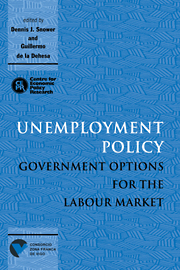Book contents
- Frontmatter
- Contents
- List of figures
- List of tables
- Preface
- Acknowledgements
- List of conference participants
- 1 Introduction
- PART ONE GENERAL POLICY ISSUES
- PART TWO DEMAND MANAGEMENT AND SUPPLY-SIDE POLICY
- PART THREE SUBSIDISING EMPLOYMENT AND TRAINING
- 6 The simple economics of benefit transfers
- Discussion
- Discussion
- 7 Wage subsidy programmes: alternative designs
- Discussion
- Discussion
- 8 Technological development, competition from low-wage economies and low-skilled unemployment
- Discussion
- 9 Macroeconomic and policy implications of shifts in the relative demand for skills
- Discussion
- 10 Would cutting payroll taxes on the unskilled have a significant impact on unemployment?
- Discussion
- 11 Preventing long-term unemployment: an economic analysis
- Discussion
- Discussion
- PART FOUR LABOUR MARKET REGULATIONS
- PART FIVE POLICY, JOB REALLOCATION AND THE UNEMPLOYMENT–PRODUCTIVITY RELATION
- PART SIX COMPARING UNEMPLOYMENT POLICIES
- Index
10 - Would cutting payroll taxes on the unskilled have a significant impact on unemployment?
Published online by Cambridge University Press: 07 September 2010
- Frontmatter
- Contents
- List of figures
- List of tables
- Preface
- Acknowledgements
- List of conference participants
- 1 Introduction
- PART ONE GENERAL POLICY ISSUES
- PART TWO DEMAND MANAGEMENT AND SUPPLY-SIDE POLICY
- PART THREE SUBSIDISING EMPLOYMENT AND TRAINING
- 6 The simple economics of benefit transfers
- Discussion
- Discussion
- 7 Wage subsidy programmes: alternative designs
- Discussion
- Discussion
- 8 Technological development, competition from low-wage economies and low-skilled unemployment
- Discussion
- 9 Macroeconomic and policy implications of shifts in the relative demand for skills
- Discussion
- 10 Would cutting payroll taxes on the unskilled have a significant impact on unemployment?
- Discussion
- 11 Preventing long-term unemployment: an economic analysis
- Discussion
- Discussion
- PART FOUR LABOUR MARKET REGULATIONS
- PART FIVE POLICY, JOB REALLOCATION AND THE UNEMPLOYMENT–PRODUCTIVITY RELATION
- PART SIX COMPARING UNEMPLOYMENT POLICIES
- Index
Summary
Introduction
Reduce non-wage labour costs, especially in Europe, by reducing taxes on labour.
So says the 1994 OECD Jobs Study as one if its policy recommendations for the reduction of unemployment. As a further recommendation, it adds
Reduce direct taxes (social security and income taxes) on those with low earnings.
The idea here is to boost the relative demand for low-skill workers.
The first recommendation is one which is often made. Indeed, commentators point to the very high level of social security contributions faced by employers in many European countries (over 40 per cent in Belgium, France and Italy, for example) as being crucial to the allegedly poor state of the European labour market, including its high unemployment. However, a glance at Denmark, where employers pay no social security contributions, non-wage labour costs are negligible and unemployment is around the EU average quickly reveals the weakness of this view. Figure 10.1 shows why. Here we see average unit labour costs (i.e. labour costs incurred in producing $10 of value added) in 13 OECD countries where we have split these into wage costs and payroll taxes. Figure 10.1 shows clearly that there is no significant relationship between unit labour costs and payroll tax rates, the slope of a regression of the former on the latter being a mere 14 cents for every 10 percentage points of tax, with a t-static of 0.5.
- Type
- Chapter
- Information
- Unemployment PolicyGovernment Options for the Labour Market, pp. 296 - 328Publisher: Cambridge University PressPrint publication year: 1997
- 16
- Cited by



